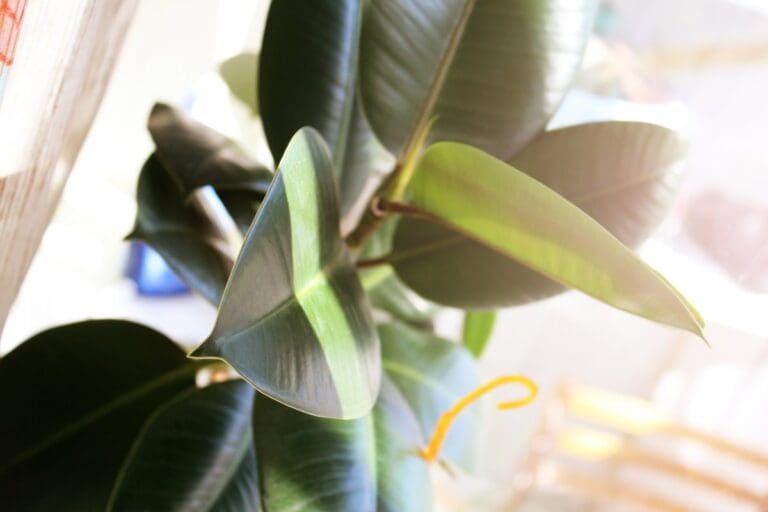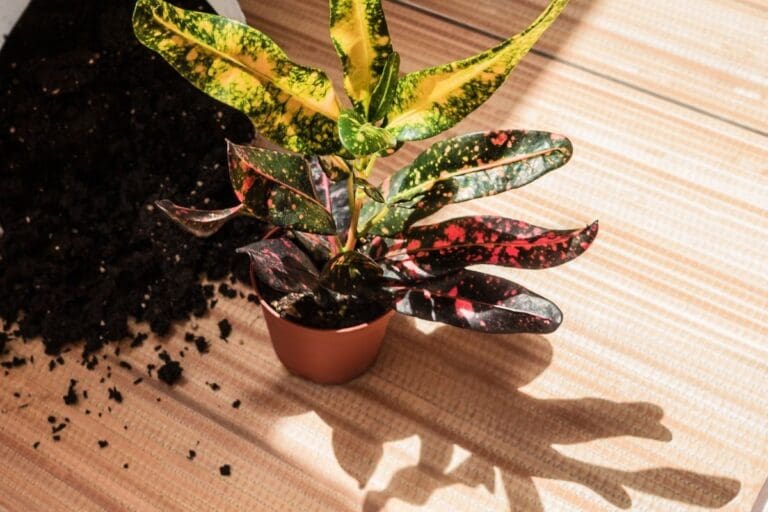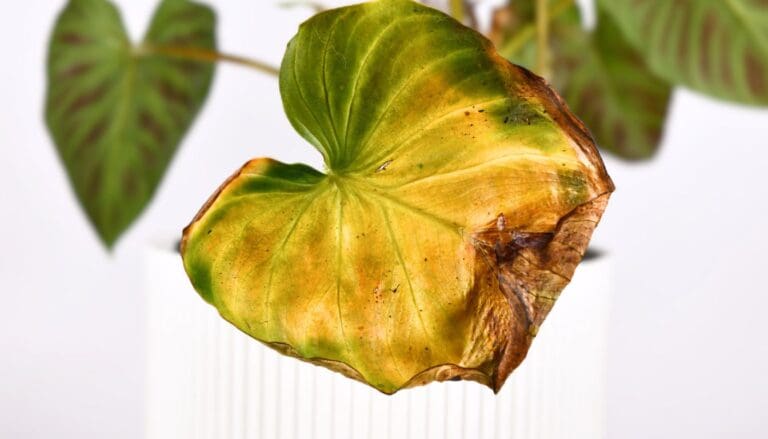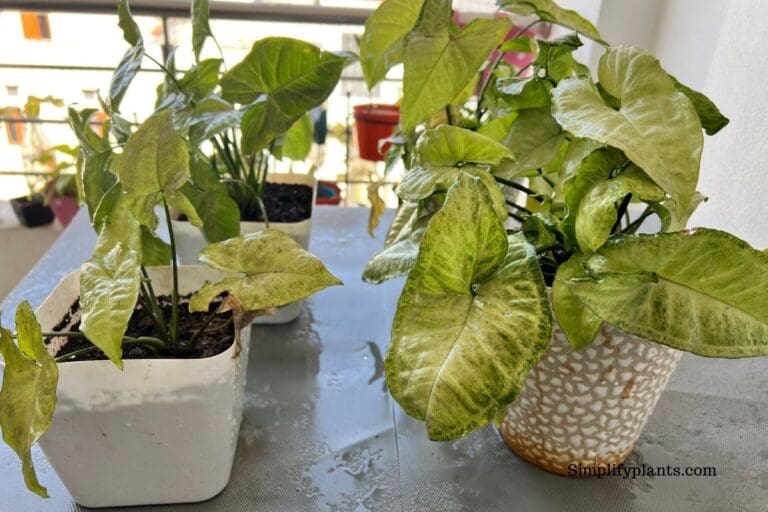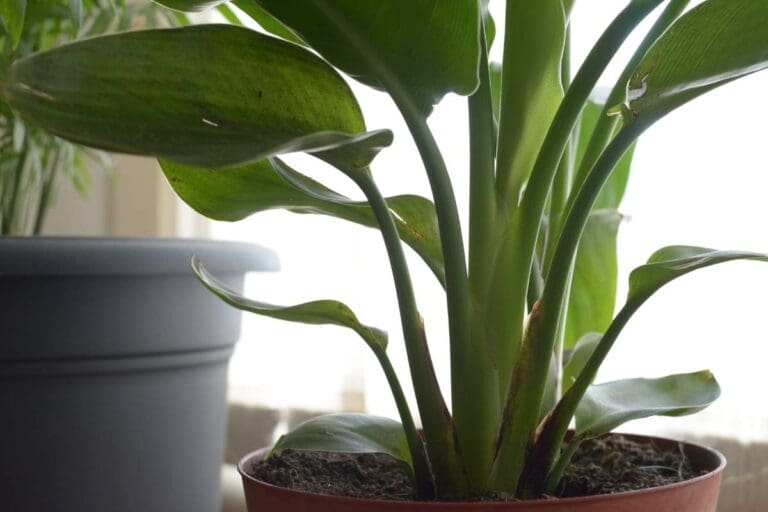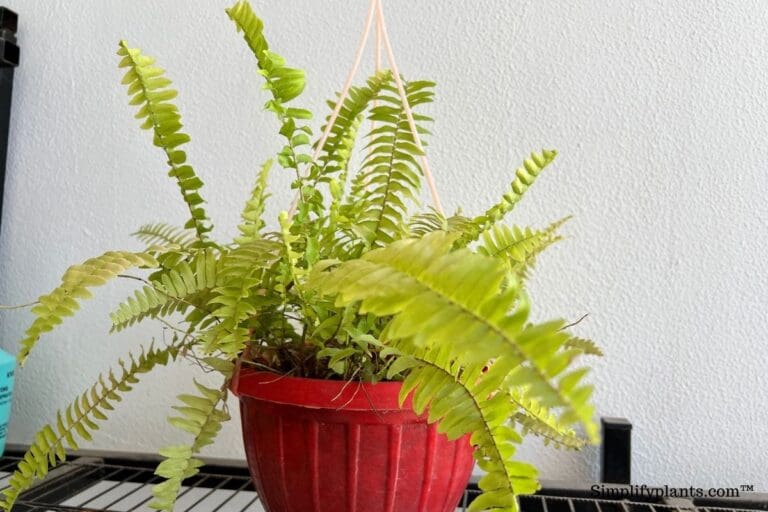ZZ Plant Watering Guide: How Much, How Often & More!
ZZ plants are resilient plants and are very tolerant of all conditions. Their watering needs are straightforward and easy to follow by any plant parent. Although it’s not a tricky matter, we should understand the water requirement of the ZZ plant as overwatering can be harmful.
ZZ plants need water only when the soil is completely dry. The best way is to water them thoroughly when the soil gets dry. You shouldn’t follow a fixed watering regime to water your ZZ plant as the water requirement changes with the place, temperature, season, and light.
Though ZZ plants are forgiving, we should still know them and their watering needs. If you are still struggling with the watering needs of the ZZ plant, we are here to help.
Just keep following me till the end of this article, and I promise you will not have a single question in your mind regarding watering your ZZ plant.

Please note: Simplify Plants is reader-supported. Some links in the post are affiliate links and I get a commission from purchases made through links in the post.
When to water my ZZ plant?
The watering ZZ plant needs to be taken care of a little extra. We need to know how to season matters while watering your ZZ plant.
Summer
ZZ plants like to be on the drier side, which gives us a clear picture of their water needs. They need water when the soil is completely dry; However, the frequency of watering the ZZ plant increases during summer.
The sun is hot, so the soil dries faster during the warmer seasons. Ideally, with all-day exposure to the indirect sun, your ZZ plant will need water once a week.
You should not water your ZZ plant by following any watering regime in any case because it can lead to overwatering. Overwatering the ZZ plant is very harmful and will result in root rot, fungal diseases, and other related issues.
Winter
During the winter, the light and heat from the sun are very dull, due to which the soil takes time to dry out. The plant goes into sleep mode, which needs the least attention at this time.
ZZ plant prefers the soil to be completely dry before the next watering. The watering should be done by checking the soil moistness.
Usually, they need water once or twice a month. If the weather is too cold, the plant may go without water for about a month or two.
How do you know when a ZZ plant needs water?
ZZ plants are very efficient at managing their water requirements but will show some signs when they are thirsty.
Prolonged deficiency of water can lead to nutrient deficiency in the plant.
Even if the ZZ plant is adequately fertilized, the lack of water will hinder the supply of nutrients to all parts of the plant resulting in a weak plant.
Some signs that your ZZ plant needs water immediately are:
Dry and brown leaf tips

Your ZZ plant may seem healthy overall, but if you closely notice, you may find shriveled, dry and brown tips on the leaves. ZZ plants have waxy and turgid leaves, which become soft due to drying out.
That is a clear sign of dehydration in the ZZ plant due to prolonged lack of water and can make the leaves lose their moisture and fall out in the long term.
Dropping leaves
ZZ plants are semi-succulent, and they have an ingenious mechanism for storing water during periods of water deficiency.
If you see leaves dropping from your ZZ plant one at a time, then it is a way of your plant sacrificing its small parts to save the energy for the rest of the plant foliage.
That usually happens when the plant lacks water. Thus, it is pretty clear that the plant needs water to regain its health.
Dry Soil
Dry soil simply means the soil is bone dry, not just dry from the top. This means that due to the lack of water in the soil, the leaves are also losing their moisture.
The soil will become dry, and the color will change to very light brown, and cracks will start appearing.
The best way to know the soil is dry is through its color. But if you are a beginner, we recommend using a moisture meter for the same.
If you see the moisture level below 5, you can water them, and if it drops below 2 or 3, then the soil is very dry.
Soil pulling away from the edge on the top
When the ZZ plant is not watered for a long time, the soil pulls away from the top edges. The soil is dehydrated and needs water.
The roots are also dehydrated by this time, and the water and nutrient supply is also suffering.
The reason is clearly under watering, which can be either due to ignorance or following any watering regime for a long time without considering other factors and the plant’s need.
The factors that affect the water requirement are sunlight exposure to the plant, temperature level, etc., which positively affect the plant’s water needs.
We can still work out with the plant by using a bottom watering method, rehydrating the plant to a decent amount the first time.
Droopy leaves

ZZ plants are firm, reflecting, and turgid that any planter can die for. If the leaves lose their shine, then the plants lose their beauty. The plant needs water, nutrients, and air to maintain its beauty and glossiness.
Water is one of the plant’s basic needs for maintaining its health. If the plant is prone to water deficiency for a long time, the leaves lose their moisture, which helps them stay firm and glossy.
Due to lack of moisture, the leaves start to droop and wilt and even turn brown. If you see droopy and pale leaves, the plant is suffering from water deficiency for a long time. You need to take care of the water routine properly.
Also read: How Long Can House Plants Go Without Water?
Factor affecting the needs of water
ZZ plants are very hardy plants and do not get affected easily due to external factors.
However, the plant’s water and care requirement will vary depending upon the change in environment and other factors. Let us dive into further details.
Soil
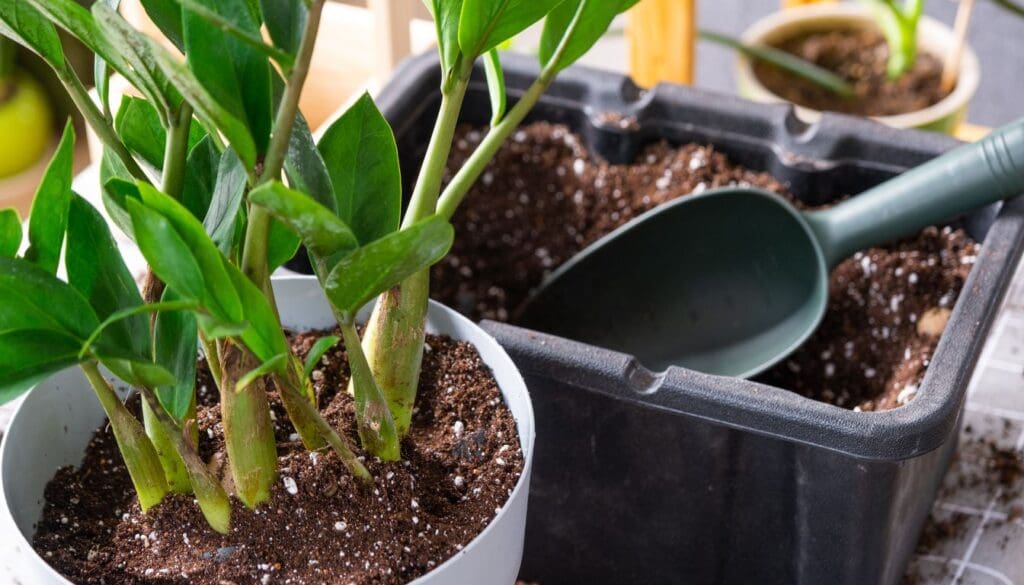
Soil mix plays a vital role in determining the water requirement of the ZZ plant. The most crucial factor is how fast the soil dries out.
If the soil mix is heavy or poorly draining, then the water will not drain properly, and the plants will suffer.
Most beginners end up watering their ZZ plant by looking at the topsoil. It is not the right way to judge the water requirement as the soil at the bottom of the pot may be soaked even if the topsoil is dry. That usually happens when we use a heavy potting mix that doesn’t drain well.
It needs to be taken care of as soon as possible. The soil mix should be changed or mixed with perlite or cactus mix to make the soil well-draining.
Season
The season is one of the crucial factors affecting the water need of the ZZ plant. Since your ZZ plant likes its soil to be completely dry before the next watering, the season makes a difference in the plant’s water needs.
During a dry climate, the soil will dry out more quickly, and the leaves will also lose water quickly; thus, the plant will need water rapidly. You need to keep a frequent check on your plant during this time.
When the mercury drops during winter, the plant will not require water more than once a week.
Temperature
ZZ plants can thrive in various temperature levels, but with temperature change, the water needs also change and vary.
Ideally, the temperature range between 65 degrees Fahrenheit to 90 degrees Fahrenheit keeps the ZZ plant healthy for an extended period.
If the temperature level is high, the plant will need water frequently as the soil will dry faster. The lack of water at this time may lead to droopy and wilted leaves.
If the temperature level is low, then the watering frequency will reduce because the soil will take a lot more time to dry out completely.
Pot type
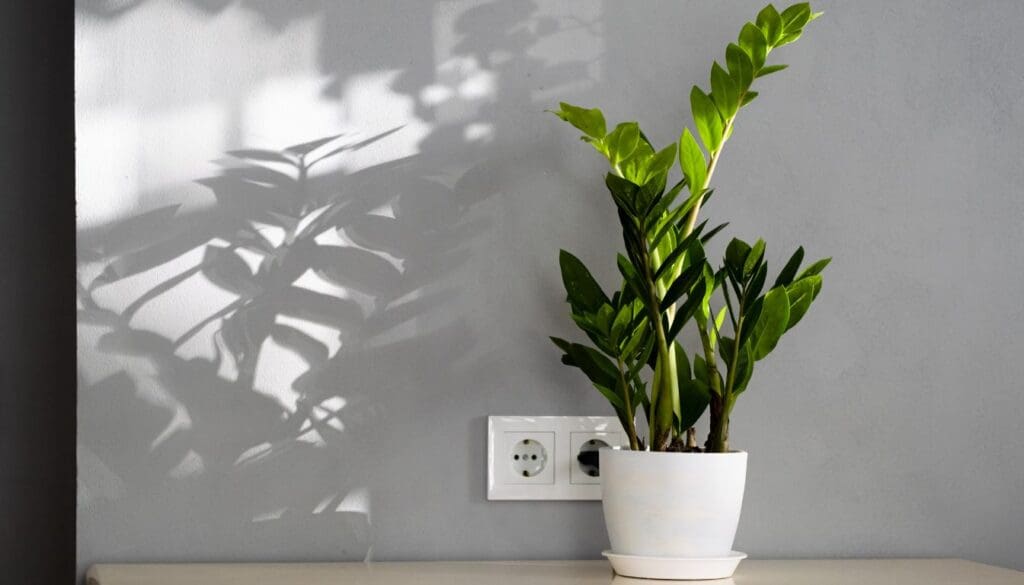
ZZ plants are not water lovers and like pots that allow airflow in the soil. Let’s find out which pot type is best for your ZZ plant.
Terracotta pots are porous, which allows free transfer of air and water throughout the container walls. These pots are considered the best for your ZZ plant as it will help the soil dry out the soil.
You can also go with ceramic but make sure you have enough drainage holes at the bottom.
Humidity
ZZ plants are tropical plants, but they don’t fancy humidity a lot. Humidity is essential for every plant and affects the plant’s watering needs to some extent.
If the humidity gets too high around your ZZ plant, the plant’s watering needs go down because the soil might take a longer time to dry out.
ZZ plants like the humidity of about 40-50% around them, and if the humidity is low around them, the plant will take less time to dry out.
However, humidity is not the most crucial factor that affects the watering needs of the plant but can make a little difference.
Also read: Does ZZ plant like to be misted?
Light
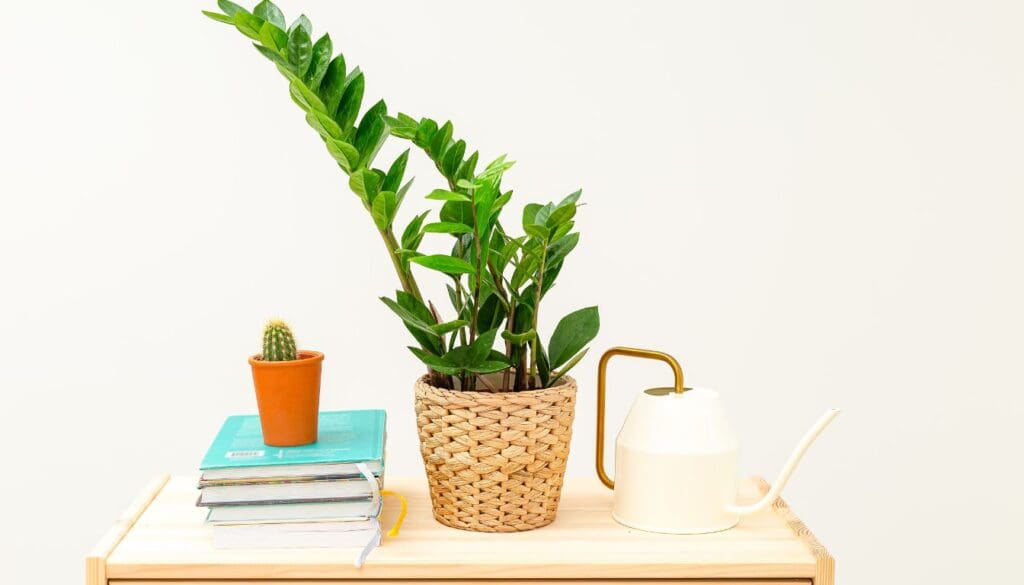
Light is one of the critical factors in deciding when the plant needs water. We all know light helps in the growth and development of the plant.
The more your ZZ plants get sunlight, the more water it will need. The soil will take at least 3-4 weeks to dry out completely.
The ZZ plant should not be exposed to direct light for more than 1-2 hours a day; otherwise, the leaves may lose their moisture and turn brown. Morning and evening sun is preferred.
Keep proper care of the plant and its watering needs during summer as the plant should not get bone dry due to ignorance. It can lead to wilting of the plant.
Also read: How much light do ZZ plant need?
How much water does a ZZ plant need?
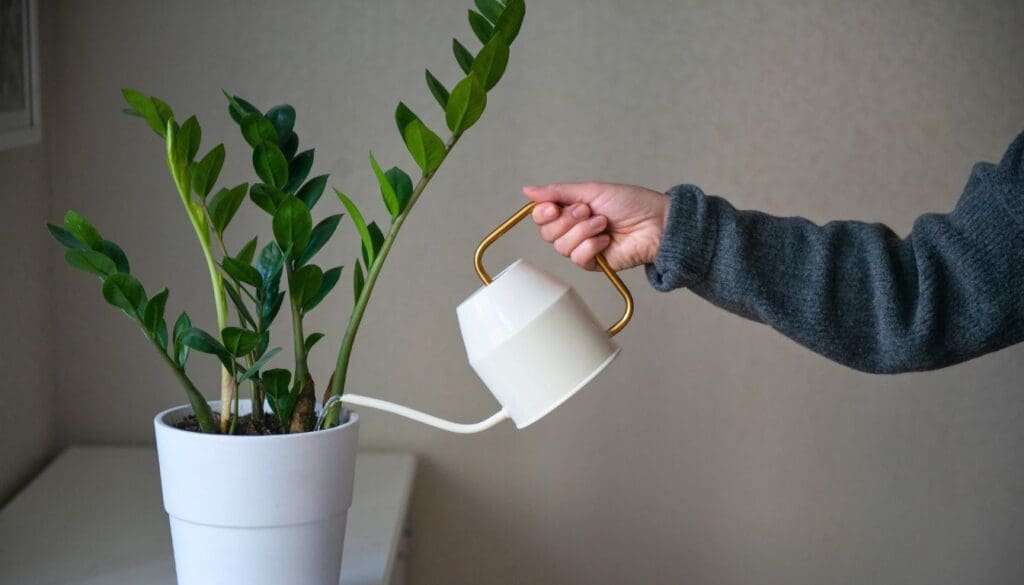
We can never be precise about how much water a plant needs at any point in time. But we are sure about one thing that the plant should not be left soggy after watering them.
ZZ plants like to be on the drier side, which means you should not overwater them, and the pot must have a proper drainage system. That ensures that the water doesn’t remain stagnant in the pot.
Usually, you can use 1 cup of water for small and medium pots, and for large ones, you can use about 2 cups to water them.
If you are not sure, always prefer watering the ZZ plant thoroughly and let the excess water drain out completely.
Also, don’t water your ZZ plant through the leaves as they do not love water sitting on them for too long. Water left on the leaves can lead to issues both internally and externally.
Signs of overwatered ZZ plant
ZZ plants do not tolerate overwatering, and they will tell you in many ways that they are suffocated. Following are the signs that your ZZ plant is overwatered:
- Brown spots on foliage
- Root rot
- Foul odor
- Yellow foliage
- Mold on the soil surface
- Mushy stems
Signs of under-watered ZZ plant
Underwatering the ZZ plant is safe, but you must not overdo that as well. If you underwater the ZZ plant for an extended period, then your plant may suffer from the following problems:
- Dry leaf tips
- Drooping leaves
- Dropping foliage
- Brown leaves
- Shriveled petioles
- Stunted growth
- Soil pulling away
Also read: Underwatering vs. Overwatering
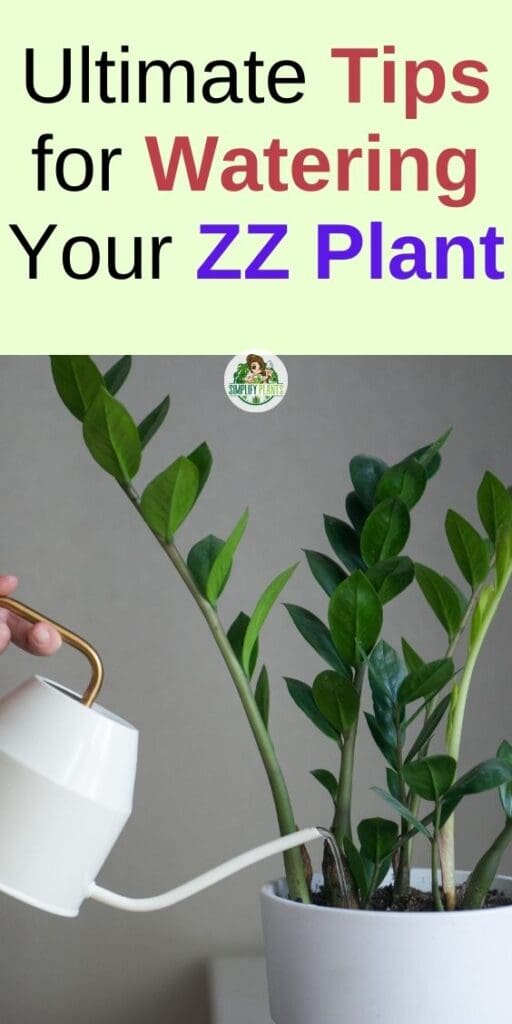
Related question
Should I mist my ZZ plant?
ZZ plants thrive in almost all states but don’t like excess humid climates. That also means that they do not like to be misted.
The leaves are glossy and turgid as they store water, but this doesn’t mean that they like water on them. If the water sits on the foliage for long periods, the leaves will turn brown and have patches on them.
Keep the plant on the drier side and also maintain humidity below 50% around the plant for best results.
However, an occasional neem oil mist or misting to clean the leaves is excellent for them.
Can you water the ZZ plant with tap water?
You can water ZZ plants with tap water. They are sturdy and thrive in all conditions and all routines.
However, if your tap water contains a lot of chemicals like chlorine and fluoride added to it, then you can let the bucket of water sit overnight and use the water the next morning for the best result.
Sources: ZZ plant study, College of agricultural studies, University of Vermont, National science foundation.
Recommended Garden Supplies
| Product Image | Our Recommended Gardening Supplies | Check Offers! |
|---|---|---|
Top Top
Top
Top
Top
Top
Top
Top
Top | rePotme Houseplant and Tropical Classic Potting Soil Mix | Check Offer On Amazon |
 Top
Top
Top
Top
Top
Top
Top
Top | Espoma Organic Indoor Plant Food | Check Offer On Amazon |
 Top
Top
Top
Top
Top
Top
Top
Top | GooingTop LED Grow Light 6000K Full Spectrum Clip Plant Growing Lamp | Check Offer On Amazon |
 Top
Top
Top
Top
Top
Top
Top
Top | Soil Moisture Meter | Check Offer On Amazon |
 Top
Top
Top
Top
Top
Top
Top
Top | Govee Hygrometer Thermometer, Bluetooth Enabled! | Check Offer On Amazon |
 Top
Top | LEVOIT Humidifiers for Large Room(Best For Plants) | Check Offer On Amazon |
 Top
Top
Top
Top
Top
Top
Top
Top | Upgraded DIY Automatic Drip Irrigation Kit, 15 Potted Houseplants Support | Check Offer On Amazon |
 Top
Top
Top
Top
Top
Top
Top
Top | Stainless Steel Heavy Duty Gardening Tool Set | Check Offer On Amazon |
 Top
Top
Top
Top
Top
Top
Top
Top | Bonide Insecticidal Soap | Check Offer On Amazon |
 Top
Top
Top
Top
Top
Top
Top
Top | Bonide 32 oz Spray Neem Oil for Organic Gardening | Check Offer On Amazon |
 Top
Top
Top
Top
Top
Top
Top
Top | Garden Safe Fungicide | Check Offer On Amazon |

